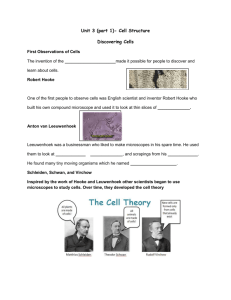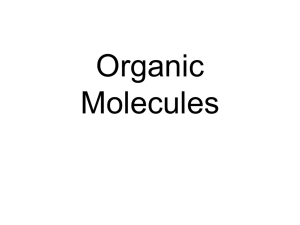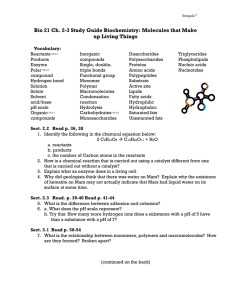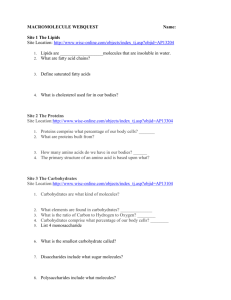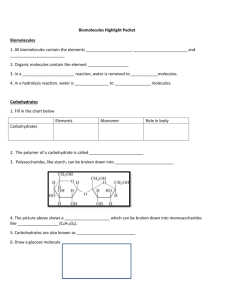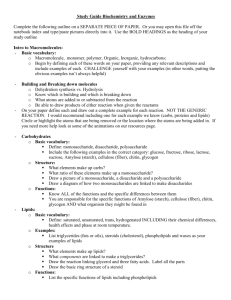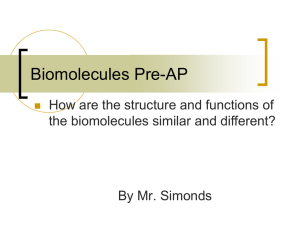QUESTION
advertisement
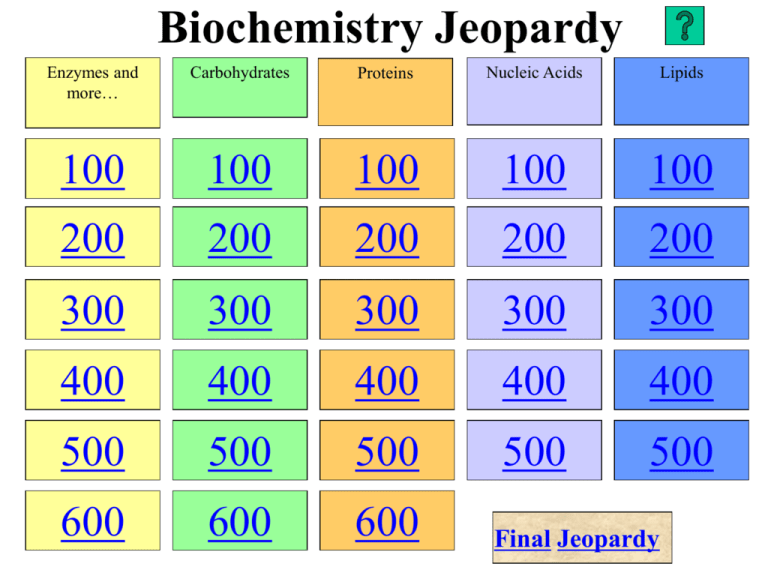
Biochemistry Jeopardy Enzymes and more… Carbohydrates Proteins Nucleic Acids Lipids 100 100 100 100 100 200 200 200 200 200 300 300 300 300 300 400 400 400 400 400 500 500 500 500 500 600 600 600 Final Jeopardy Help (1) Save a duplicate of this template. (2) Enter all answers and questions in the normal view. (view/normal) (3) Change the category headings in the normal view (view/normal) (4) View as a slideshow. (5) Use the home red button after each question. ©Norman Herr, 2003 A-100 • QUESTION: Formal name of protein that acts as a biological catalyst. • ANSWER: Enzyme Answer Question A-200 • QUESTION: The active site and the substrates have complementary shapes, often compared to as a ____ and _____ ____. • ANSWER: Lock and Key model Answer Question A-300 • QUESTION: Describe the amount of energy needed for enzymes with OR without an enzyme. • ANSWER: Activation energy without enzyme has an higher energy threshold, compared to an enzyme with activation energy, less energy is needed. Answer Question A-400 • QUESTION: Enzymes are known to denature based on what type of regulation activity? **Hint: Recall Pineapple Enzyme Lab.** • ANSWER: Temperature. Answer Question A-500 • QUESTION: Based on the diagram, which structure best represents a substrate. • ANSWER: Circle and Square represent molecules that are able to attach and detach in the enzyme-substrate complex. Answer Question A-600 • QUESTION: Lactose is found in milk products. It is converted by the body into a usable form in a series of chemical reactions. The diagram shows the series of reactions that convert lactose into a usable form. If enzyme 2 is denatures, the levels of which substance will increase? • ANSWER: Galactose Answer Question B-100 • QUESTION: Give two examples of carbohydrates. • ANSWER: Starch, sugar or cellulose Answer Question B-200 • QUESTION: What is a monosaccharide? • ANSWER: single sugar molecule Answer Question B-300 • QUESTION: What kind of energy is a carbohydrate used for? • ANSWER: immediate, short term energy Answer Question B-400 • QUESTION: What elements make up carbohydrates? • ANSWER: Carbon, Hydrogen, Oxygen Answer Question B-500 • QUESTION: Give three food examples of carbohydrates. • ANSWER: honey, potatoes, table sugar Answer Question B-600 • QUESTION: What is the definition of a macromolecule? • ANSWER: Many polymers put together to make a giant molecule Answer Question C-100 • QUESTION: Name three functions of a protein. • ANSWER: build/repair tissue, movement, structure, regulation, defense Answer Question C-200 • QUESTION: What are the monomers for proteins? • ANSWER: Amino Acids Answer Question C-300 • QUESTION: What are the elements that make up proteins? • ANSWER: Carbon, Hydrogen, Oxygen and Nitrogen Answer Question C-400 QUESTION: What is the name of a protein that speeds up chemical reactions? Answer: Catalysts Answer Question C-500 • QUESTION: Name the 4 Macromolecules that make up all living things. • ANSWER: Proteins, Carbs, Lipids, Nucleic Acids Answer Question C-600 • QUESTION: Amino Acid is to protein as ____________ is to carbohydrates • ANSWER: monosaccharide Answer Question D-100 • QUESTION: Name a function of DNA • ANSWER: Storage of Genetic Information. Answer Question D-200 QUESTION: Name the functions for RNA ANSWER: Protein Synthesis. Answer Question D-300 • QUESTION: What is the basic building block of nucleic acid? • ANSWER: Nucleotide, 5 carbon sugar, phosphate, nitrogenous base Answer Question D-400 • QUESTION: What elements make up nucleic acids? • ANSWER: Carbon, Hydrogen, Oxygen, Nitrogen and Phosphorous Answer Question D-500 • QUESTION: Where is nucleic acid/DNA found in cells? • ANSWER: nucleus Answer Question E-100 • QUESTION: What elements make up lipids? • ANSWER: Carbon, Hydrogen, Oxygen Answer Question E-200 • QUESTION: What kind of energy storage does a lipid provide? • ANSWER: long term Answer Question E-300 • QUESTION: Name two functions of a lipid besides long term energy storage. • ANSWER: insulation and repels water Answer Question E-400 • QUESTION: Give a non food example of a lipid. • ANSWER: phospholipid bilayer or steroid or cholesterol Answer Question E-500 • QUESTION: What are the FIVE types of lipids? • ANSWER: Fats (Saturated and Unsaturated), Waxes, Oils, Phospholipids, Steroids, Cholesterol). Answer Question FINAL JEOPARDY • QUESTION: What is the study of organic compounds? • ANSWER: Biochemistry Answer Question BONUS JEOPARDY • QUESTION: How are all four macromolecules made? Name the process. • ANSWER: they are complex molecules made from smaller molecules. Dehydration synthesis. Answer Question



